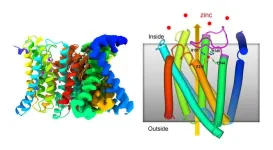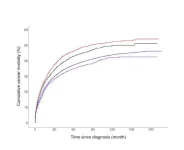(Press-News.org) In a study published in PNAS, Prof. XIAO Yilin’s group from the University of Science and Technology of China (USTC) of the Chinese Academy of Sciences (CAS) quantitatively determined, for the first time, the chemical composition of supercritical fluids in deep subduction zones, through 3D imaging modelling of ultrahigh-pressure (UHP) multiphase fluid inclusions, and revealed the important role of supercritical fluids in the cycling of carbon and sulfur in subduction zones, which is of great importance for an in-depth and systematic understanding of the role of supercritical fluids in nature.
Fluids, including oceans, lakes, rivers, and the wide range of geological fluids found in the Earth’s interior, are inseparable parts and important media, helping to transfer the matter and energy among different layers of the Earth. Depending on their geochemical properties, they can be further divided into water-rich fluids, water-bearing melts, and supercritical fluids.
Formed amidst high temperature and pressure, supercritical fluids are characterized by relatively low viscosity, high activity, and exceptional elemental mobility. These unconventional physicochemical properties endow them with a vital role in triggering meso-deep seismicity and volcanism, facilitate subduction zone elemental transport, material cycling, and metal enrichment mineralization, and influence the evolution of the Earth's habitability. However, it remains a challenge to identify a supercritical fluid activity from natural samples, especially when the critical and quantitative geochemical indicators are severely scarce.
The researchers studied the UHP metamorphic vein body of the continental ultra-deep subduction zone in the Dabie Mountains, and found a large number of multiphase fluid inclusions coexisting with the iconic UHP metamorphic mineral, Kochnite. The inclusions are preserved with multiple seed minerals with a relatively consistent overall assemblage, consisting mainly of quartz, calcite, anhydrite, and a large amount of water.
Systematic petrographic, laser Raman, and elemental surface sweep studies showed that the multiphase fluid inclusions in omphacite and garnet are primary UHP fluid inclusions, preserving the chemical composition of the deeper high-pressure fluids in the subduction zone intact. 3D laser Raman modeling and quantitative compositional calculations of these inclusions recovered the original vein-forming fluid composition recorded in the multiphase fluid inclusions. The fluids were shown to contain mainly SiO2, CaO, and water, as well as significant amounts of volatile elements such as carbon and sulfur.
Furthermore, the researchers discovered that fluids preserved in the inclusions have supercritical properties (e.g., migration capacity) and compositional characteristics. These supercritical fluids are highly efficient in activating and transporting carbon and sulfur in subduction zone sheets, and may transport them into the mantle wedge and even the deep mantle, thus having a wide and important impact on the efficiency and flux of the carbon-sulfur cycle between the Earth's surface and the deep, as well as the evolution of the habitability of the Earth.
This study provided a detailed characterization of the properties of supercritical fluids in deep subduction zones. It also revealed the critical role the UHP fluids played in terms of carbon and sulfur cycle, which has long been underestimated.
END
Researchers determine quantitative composition of ultrahigh-pressure fluid in deep subduction zones
2023-06-09
ELSE PRESS RELEASES FROM THIS DATE:
USTC reveals reconfiguration process of solar eruptions
2023-06-09
Recently, a research team led by Prof. GOU Yanyu from the University of Science and Technology of China (USTC) of the Chinese Academy of Sciences (CAS) found that the solar outburst structure undergoes a complex reconfiguration evolution during the early outbursts, thus making important advances in the study of solar outburst activity. This study was published in Nature Astronomy.
In classical images, the core structure of a solar eruption is a magnetic rope consisted of spirally wound magnetic lines. When the eruption begins, the magnetic ropes around the core are transformed by magnetic reconnection ...
DNA facilitates escape from metastability
2023-06-09
Prof. LIANG Haojun from the University of Science and Technology of China (USTC) of the Chinese Academy of Sciences (CAS) proposed a new method to escape from metastability for self-assembly in a far-from-equilibrium system. The study was published in PNAS.
Self-assembly refers to the process in which assembled primitive elements (molecules, nanoparticles, etc.) spontaneously form ordered structures through non-covalent interactions. Its excellent capacity to create new materials has drawn attention. In an ...
Single quantum bit achieves complex systems modeling
2023-06-09
A team led by Academician GUO Guangcan from the University of Science and Technology of China (USTC) of the Chinese Academy of Sciences (CAS), with collaborative efforts from the University of Manchester, and Nanyang Technological University, has achieved new progress in applying quantum technologies in complex systems modeling. The results were published in Nature Communications on May 6.
Stochastic modeling can help us to predict the future behavior of complex processes, which are non-Markovian. In order to simulate a non-Markovian process, a memory is of necessity to store a large amount of observed information about the past of the system. However, ...
Zinc transporter has built-in self-regulating sensor
2023-06-09
UPTON, NY — Scientists at the U.S. Department of Energy’s (DOE) Brookhaven National Laboratory have determined the atomic-level structure of a zinc-transporter protein, a molecular machine that regulates levels of this crucial trace metal micronutrient inside cells. As described in a paper just published in Nature Communications, the structure reveals how the cellular membrane protein shifts its shape to move zinc from the environment into a cell, and temporarily blocks this action automatically when zinc levels inside the cell get too high.
“Zinc is important for many biological ...
New model offers a way to speed up drug discovery
2023-06-09
CAMBRIDGE, MA — Huge libraries of drug compounds may hold potential treatments for a variety of diseases, such as cancer or heart disease. Ideally, scientists would like to experimentally test each of these compounds against all possible targets, but doing that kind of screen is prohibitively time-consuming.
In recent years, researchers have begun using computational methods to screen those libraries in hopes of speeding up drug discovery. However, many of those methods also take a long time, as most of them calculate each target protein’s ...
Black, Hispanic survivors of breast cancer have higher death rates from second cancers
2023-06-09
Hispanic and non-Hispanic Black female survivors of breast cancer experience higher death rates after being diagnosed with a second primary cancer than members of other ethnic and racial groups, according to recent research from investigators at the Johns Hopkins Kimmel Cancer Center.
In a study of nearly 40,000 adult survivors of breast cancer, the risk of death from a second cancer was 12% higher among non-Hispanic Black survivors and 8% higher among Hispanic survivors compared with non-Hispanic white survivors. Survivors in racial and ethnic minorities were diagnosed with second cancers ...
Mouse models of adolescent binge drinking reveal key long-lasting brain changes
2023-06-09
UNIVERSITY PARK, Pa — Heavy alcohol consumption may cause permanent dysregulation of neurons, or brain cells, in adolescents, according to a new study in mice. The findings suggest that exposure to binge-levels of alcohol during adolescence, when the brain is still developing, lead to long-lasting changes in the brain’s ability to signal and communicate — potentially setting the stage for long-term behavioral changes and hinting towards the mechanisms of alcohol-induced cognitive changes in humans.
“What we’re seeing here,” said Nikki Crowley, assistant professor in biology and biomedical engineering ...
Infants and toddlers up to 5 years old can participate in Shape Up! Keiki study at Pennington Biomedical
2023-06-09
The Pennington Biomedical Research Center is looking for children 5 years old and younger to participate in the Shape Up! Keiki research study. The purpose of the Shape Up! Keiki research study is to create a better way to measure and describe health from body shape.
“Parents can learn more about their child’s health by joining the Shape Up! Keiki study, while also providing important information that will help us find quick ways to measure obesity status and health based on a child’s body ...
Seenu Hariprasad named University of Chicago Chair of Ophthalmology and Visual Science
2023-06-09
Seenu M. Hariprasad, MD, the Shui-Chin Lee Professor of Ophthalmology, will be appointed Chair of the Department of Ophthalmology and Visual Science, effective July 1, 2023. He has been serving as Interim Chair since 2020.
Hariprasad is an internationally recognized vitreoretinal surgeon who originally joined the University of Chicago in 2005. Over the course of his career, he has developed a strong track record as a clinician, surgeon, researcher, educator, and leader in his department. He is a leading specialist in various vitreoretinal disorders, including macular degeneration, diabetic ...
Liquid metal sticks to surfaces without a binding agent
2023-06-09
Everyday materials such as paper and plastic could be transformed into electronic “smart devices” by using a simple new method to apply liquid metal to surfaces, according to scientists in Beijing, China. The study, published June 9 in the journal Cell Reports Physical Science, demonstrates a technique for applying a liquid metal coating to surfaces that do not easily bond with liquid metal. The approach is designed to work at a large scale and may have applications in wearable testing platforms, flexible devices, and soft robotics.
“Before, we thought that it was impossible for liquid metal ...





